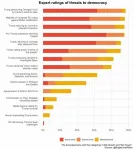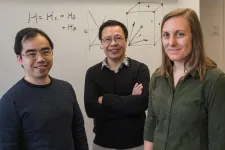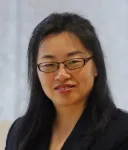(Press-News.org) In recent years, engineers have found ways to modify the properties of some "two- dimensional" materials, which are just one or a few atoms thick, by stacking two layers together and rotating one slightly in relation to the other. This creates what are known as moiré patterns, where tiny shifts in the alignment of atoms between the two sheets create larger-scale patterns. It also changes the way electrons move through the material, in potentially useful ways.
But for practical applications, such two-dimensional materials must at some point connect with the ordinary world of 3D materials. An international team led by MIT researchers has now come up with a way of imaging what goes on at these interfaces, down to the level of individual atoms, and of correlating the moiré patterns at the 2D-3D boundary with the resulting changes in the material's properties.
The new findings are described today in the journal Nature Communications, in a paper by MIT graduate students Kate Reidy and Georgios Varnavides, professors of materials science and engineering Frances Ross, Jim LeBeau, and Polina Anikeeva, and five others at MIT, Harvard University, and the University of Victoria in Canada.
Pairs of two-dimensional materials such as graphene or hexagonal boron nitride can exhibit amazing variations in their behavior when the two sheets are just slightly twisted relative to each other. That causes the chicken-wire-like atomic lattices to form moiré patterns, the kinds of odd bands and blobs that sometimes appear when taking a picture of a printed image, or through a window screen. In the case of 2D materials, "it seems like anything, every interesting materials property you can think of, you can somehow modulate or change by twisting the 2D materials with respect to each other," says Ross, who is the Ellen Swallow Richards Professor at MIT.
While these 2D pairings have attracted scientific attention worldwide, she says, little has been known about what happens where 2D materials meet regular 3D solids. "What got us interested in this topic," Ross says, was "what happens when a 2D material and a 3D material are put together. Firstly, how do you measure the atomic positions at, and near, the interface? Secondly, what are the differences between a 3D-2D and a 2D-2D interface? And thirdly, how you might control it -- is there a way to deliberately design the interfacial structure" to produce desired properties?
Figuring out exactly what happens at such 2D-3D interfaces was a daunting challenge because electron microscopes produce an image of the sample in projection, and they're limited in their ability to extract depth information needed to analyze details of the interface structure. But the team figured out a set of algorithms that allowed them to extrapolate back from images of the sample, which look somewhat like a set of overlapping shadows, to figure out which configuration of stacked layers would yield that complex "shadow."
The team made use of two unique transmission electron microscopes at MIT that enable a combination of capabilities that is unrivalled in the world. In one of these instruments, a microscope is connected directly to a fabrication system so that samples can be produced onsite by deposition processes and immediately fed straight into the imaging system. This is one of only a few such facilities worldwide, which use an ultrahigh vacuum system that prevents even the tiniest of impurities from contaminating the sample as the 2D-3D interface is being prepared. The second instrument is a scanning transmission electron microscope located in MIT's new research facility, MIT.nano. This microscope has outstanding stability for high-resolution imaging, as well as multiple imaging modes for collecting information about the sample.
Unlike stacked 2D materials, whose orientations can be relatively easily changed by simply picking up one layer, twisting it slightly, and placing it down again, the bonds holding 3D materials together are much stronger, so the team had to develop new ways of obtaining aligned layers. To do this, they added the 3D material onto the 2D material in ultrahigh vacuum, choosing growth conditions where the layers self-assembled in a reproducible orientation with specific degrees of twist. "We had to grow a structure that was going to be aligned in a certain way," Reidy says.
Having grown the materials, they then had to figure out how to reveal the atomic configurations and orientations of the different layers. A scanning transmission electron microscope actually produces more information than is apparent in a flat image; in fact, every point in the image contains details of the paths along which the electrons arrived and departed (the process of diffraction), as well as any energy that the electrons lost in the process. All these data can be separated out so that the information at all points in an image can be used to decode the actual solid structure. This process is only possible for state-of-the-art microscopes, such as that in MIT.nano, which generates a probe of electrons that is unusually narrow and precise.
The researchers used a combination of techniques called 4D STEM and integrated differential phase contrast to achieve that process of extracting the full structure at the interface from the image. Then, Varnavides says, they asked, "Now that we can image the full structure at the interface, what does this mean for our understanding of the properties of this interface?" The researchers showed through modeling that electronic properties are expected to be modified in a way that can only be understood if the full structure of the interface is included in the physical theory. "What we found is that indeed this stacking, the way the atoms are stacked out-of-plane, does modulate the electronic and charge density properties," he says.
Ross says the findings could help lead to improved kinds of junctions in some microchips, for example. "Every 2D material that's used in a device has to exist in the 3D world, and so it has to have a junction somehow with three-dimensional materials," she says. So, with this better understanding of those interfaces, and new ways to study them in action, "we're in good shape for making structures with desirable properties in a kind of planned rather than ad hoc way."
"The methodology used has the potential to calculate from the acquired local diffraction patterns the modulation of the local electron momentum," he says, adding
that "the methodology and research shown here has an outstanding future and high interest for the materials science community."
INFORMATION:
Written by David L. Chandler, MIT News Office
Paper: "Direct imaging and electronic structure modulation of moiré superlattices at the 2D/3D interface.
https://www.nature.com/articles/s41467-021-21363-5
Both Democrats and Republicans overwhelmingly favor politicians who support generous COVID-19 relief spending, yet remain deeply polarized over the legitimacy of the 2020 presidential election results and former President Donald Trump's second impeachment. Meanwhile, political experts find that the former president's actions and those taken by congressional supporters in the aftermath of the election represent serious departures from American democratic norms.
Those are among the most recent findings of Bright Line Watch, the political science research project cofounded by Gretchen Helmke, a professor of political science at the ...
A Swansea University scientist's research into the geometrical characteristics of a physical theories is highlighted in a new paper.
Physicist Dr Farid Shahandeh said: "Imagine a physical theory whose explanation for the trajectory of an apple falling from a tree differs for Gala and Pink Lady. We know that the apple's variety has nothing to do with how it falls. A theory like this is overcomplicated.
"Any seemingly unnecessary and nonsensical parameter like this adds context to a theory's description of a physical phenomenon.
"Luckily, classical theories are not contextuality. But, we know that if we try to interpret quantum mechanics in classical terms, it becomes contextual, and consequently ...
HOUSTON - (Feb. 26, 2021) - In a twist befitting the strange nature of quantum mechanics, physicists have discovered the Hall effect -- a characteristic change in the way electricity is conducted in the presence of a magnetic field -- in a nonmagnetic quantum material to which no magnetic field was applied.
The discovery by researchers from Rice University, Austria's Vienna University of Technology (TU Wien), Switzerland's Paul Scherrer Institute and Canada's McMaster University is detailed in a paper in the Proceedings of the National Academy of Sciences. Of interest are both the origins of the effect, which is typically associated with magnetism, and its gigantic magnitude -- more than 1,000 times larger than one might observe in simple ...
Whilst a great deal of research has studied the rates of photons escaping from cold atomic gases, these studies have used a scalar description of light leaving some of its properties untested. In a new paper published in EPJ B Louis Bellando, a post-doctoral researcher at LOMA, University of Bordeaux, France, and his coauthors--Aharon Gero and Eric Akkermans, Technion-Israel Institute of Technology, Israel, and Robin Kaiser, Université Côte d'Azur, France--aim to numerically investigative the roles of cooperative effects and disorder in photon escape rates from a cold atomic gas to construct a model that considers the vectorial ...
When patients with COVID-19 arrive in emergency rooms, there are relatively few ways for doctors to predict which ones are more likely to become critically ill and require intensive care and which ones are more likely to enjoy a quick recovery.
New Yale research could help them identify important early clues. In a recent study, researchers report that a series of biomarkers, or biological signals, associated with white blood cell activation and obesity can predict severe outcomes in COVID-19 patients.
The findings appear in the Feb. 26 edition of Blood Advances.
"Patients with high levels of these markers were much more like to require care in the intensive care unit, require ventilation, or die due to their COVID-19," said Dr. Hyung Chun, ...
PHOENIX, Arizona, February 26, 2021- Promising new research shows aerobic exercise may help slow memory loss for older adults living with Alzheimer's dementia.
ASU Edson College of Nursing and Health Innovation Professor Fang Yu led a pilot randomized control trial that included 96 older adults living with mild to moderate Alzheimer's dementia.
Participants were randomized to either a cycling (stationary bike) or stretching intervention for six months. Using the Alzheimer's Disease Assessment Scale-Cognition (ADAS-Cog) to assess cognition, the results of the trial were substantial.
The six-month change in ADAS-Cog was 1.0±4.6 (cycling) and 0.1±4.1 (stretching), which were both significantly ...
Neutron scattering is a technique commonly used in physics and biology to understand the composition of complex multicomponent mixtures and is increasingly being used to study applied materials such as food. A new paper published in EPJ E by Gregory N Smith, Niels Bohr Institute, University of Copenhagen, Denmark, shows an example of neutron scattering in the area of food science. Smith uses neutron scattering to better investigate casein micelles in milk, with the aim of developing an approach for future research.
Smith, also a researcher at the ISIS Neutron and Muon Source in ...
The past century or so has seen unprecedented technological, scientific, and sociological evolution worldwide. These have accompanied global shifts in people's lifestyles and rapid changes in the environment, both natural and man-made. An unfavorable consequence of these alterations has been the increasing burden of cancer on human society.
As the country with the largest population, China has borne this burden heavily. Despite the massive progress China has made in healthcare since the 1950s, cancer has become the leading killer in the country. ...
Transfer RNAs (tRNAs) deliver specific amino acids to ribosomes during translation of messenger RNA into proteins. The abundance of tRNAs can therefore have a profound impact on cell physiology, but measuring the amount of each tRNA in cells has been limited by technical challenges. Researchers at the Max Planck Institute of Biochemistry have now overcome these limitations with mim-tRNAseq, a method that can be used to quantify tRNAs in any organism and will help improve our understanding of tRNA regulation in health and disease.
A cell contains several hundred thousand tRNA molecules, each of which consists of only 70 to 90 nucleotides folded into a cloverleaf-like pattern. At one end, tRNAs carry one of the twenty amino acids that serve as protein building blocks, while the ...
What The Study Did: Researchers investigated whether home addresses recorded in the electronic medical record could be used to accurately estimate transmission risk of SARS-CoV-2 and identify risk factors for transmission.
Authors: Joshua P. Metlay, M.D., Ph.D., of Massachusetts General Hospital in Boston, is the corresponding author.
To access the embargoed study: Visit our For The Media website at this link https://media.jamanetwork.com/
(doi:10.1001/jamanetworkopen.2021.0304)
Editor's Note: Please see the article for additional information, including other authors, author contributions and affiliations, conflict of interest and financial ...



